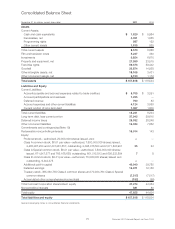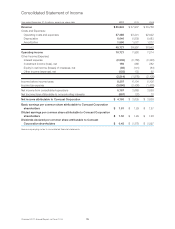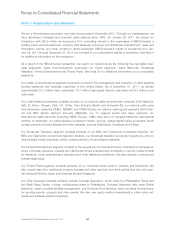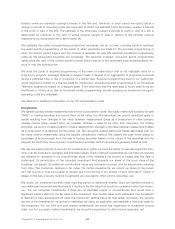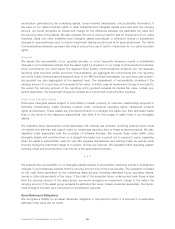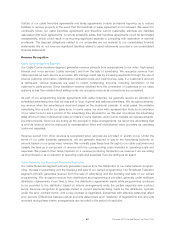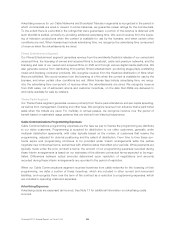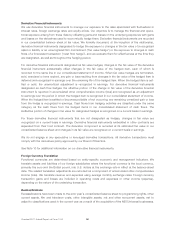Comcast 2011 Annual Report Download - page 89
Download and view the complete annual report
Please find page 89 of the 2011 Comcast annual report below. You can navigate through the pages in the report by either clicking on the pages listed below, or by using the keyword search tool below to find specific information within the annual report.Certain of our cable franchise agreements and lease agreements contain provisions requiring us to restore
facilities or remove property in the event that the franchise or lease agreement is not renewed. We expect to
continually renew our cable franchise agreements and therefore cannot reasonably estimate any liabilities
associated with such agreements. A remote possibility exists that franchise agreements could be terminated
unexpectedly, which could result in us incurring significant expense in complying with restoration or removal
provisions. The disposal obligations related to our properties are not material to our consolidated financial
statements. We do not have any significant liabilities related to asset retirements recorded in our consolidated
financial statements.
Revenue Recognition
Cable Communications Segment
Our Cable Communications segment generates revenue primarily from subscriptions to our video, high-speed
Internet and voice services (“cable services”) and from the sale of advertising. We recognize revenue from
cable services as each service is provided. We manage credit risk by screening applicants through the use of
internal customer information, identification verification tools and credit bureau data. If a customer’s account
is delinquent, various measures are used to collect outstanding amounts, including termination of the
customer’s cable service. Since installation revenue obtained from the connection of customers to our cable
systems is less than related direct selling costs, we recognize revenue as connections are completed.
As part of our programming license agreements with cable networks, we generally receive an allocation of
scheduled advertising time that we may sell to local, regional and national advertisers. We recognize advertis-
ing revenue when the advertising is aired and based on the broadcast calendar. In most cases, the available
advertising time is sold by our sales force. In some cases, we work with representation firms as an extension
of our sales force to sell a portion of the advertising time allocated to us. We also coordinate the advertising
sales efforts of other multichannel video providers in some markets, and in some markets we operate advertis-
ing interconnects. Since we are acting as the principal in these arrangements, we report the advertising that
is sold as revenue and the fees paid to representation firms and multichannel video providers as operating
costs and expenses.
Revenue earned from other sources is recognized when services are provided or events occur. Under the
terms of our cable franchise agreements, we are generally required to pay to the franchising authority an
amount based on our gross video revenue. We normally pass these fees through to our cable customers and
classify the fees as a component of revenue with the corresponding costs included in operating costs and
expenses. We present other taxes imposed on a revenue-producing transaction as revenue if we are acting
as the principal or as a reduction to operating costs and expenses if we are acting as an agent.
Cable Networks and Broadcast Television Segments
Our Cable Networks segment primarily generates revenue from the distribution of our cable network program-
ming, the sale of advertising and the licensing and sale of our owned programming. Our Broadcast Television
segment primarily generates revenue from the sale of advertising and the licensing and sale of our owned
programming. We recognize revenue from distributors as programming is provided, generally under multiyear
distribution agreements. From time to time, the distribution agreements expire while programming continues
to be provided to the distributor based on interim arrangements while the parties negotiate new contract
terms. Revenue recognition is generally limited to current payments being made by the distributor, typically
under the prior contract terms, until a new contract is negotiated, sometimes with effective dates that affect
prior periods. Differences between actual amounts determined upon resolution of negotiations and amounts
recorded during these interim arrangements are recorded in the period of resolution.
87 Comcast 2011 Annual Report on Form 10-K


